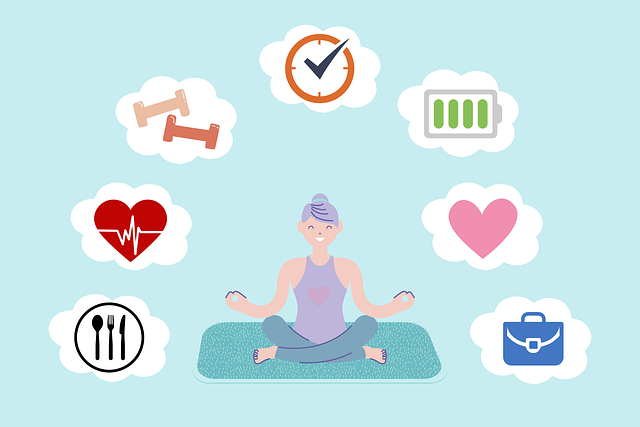Mindfulness meditation, as part of Golden Chronic Illness Therapy, is a powerful tool for managing chronic conditions, reducing anxiety, and promoting emotional well-being. This ancient practice offers a culturally sensitive, holistic approach tailored to individual needs, enhancing quality of life. By following a simple 6-step guide (set intention, create space, choose style, start small, incorporate communication, track progress), individuals can integrate mindfulness into daily life, fostering calm and connection for improved mental wellness, regardless of background or condition.
“Unwind your mind and embrace a healthier you—discover the transformative power of mindfulness meditation, a golden chronic illness therapy. This comprehensive guide explores how this ancient practice can unlock profound potential for managing persistent health conditions. From understanding its fundamentals to practical steps for beginners, we’ll navigate you through each phase. Learn effective strategies to integrate mindfulness into your daily life, ensuring sustained practice and reaping long-lasting benefits.”
- Understanding Mindfulness Meditation: Unlocking the Potential for Chronic Illness Management
- Practical Steps to Begin Your Mindfulness Journey: A Step-by-Step Guide
- Integrating Mindfulness into Daily Life: Strategies for Sustaining Practice and Reaping Benefits
Understanding Mindfulness Meditation: Unlocking the Potential for Chronic Illness Management

Mindfulness meditation is a powerful tool that has gained significant attention in recent years as an effective Golden Chronic Illness Therapy. By focusing on the present moment and cultivating awareness, individuals can unlock their potential to manage chronic conditions effectively. This ancient practice empowers people to develop a deeper understanding of their bodies and minds, fostering a sense of calm and clarity.
For those navigating chronic illnesses, mindfulness offers a holistic approach to self-care routine development for better mental health. It provides anxiety relief by helping individuals detach from stressful thoughts and emotions, thereby promoting emotional well-being. Moreover, it incorporates cultural sensitivity in mental healthcare practice, recognizing that each person’s journey is unique. Through mindfulness meditation, individuals can discover coping mechanisms tailored to their specific needs, ultimately enhancing their quality of life.
Practical Steps to Begin Your Mindfulness Journey: A Step-by-Step Guide

Embarking on a mindfulness journey can be life-changing, especially for those managing chronic illnesses. Golden Chronic Illness Therapy offers a powerful tool to enhance your mental wellness and overall emotional well-being. Here’s a practical step-by-step guide to begin:
1. Set Intention: Start by defining your purpose. Do you seek stress reduction? Improved focus? Or better sleep? Setting an intention will guide your practice and make it more meaningful.
2. Find Your Quiet Space: Create a peaceful environment free from distractions. This could be a quiet room, a serene corner of nature, or even a few minutes of solitude in your day.
3. Choose a Meditation Style: Explore various techniques like guided meditations, breathwork, body scans, or loving-kindness practices. The Mental Wellness Podcast Series Production offers diverse options to suit different preferences and needs.
4. Start Small and Consistency is Key: Begin with just 5-10 minutes daily. Consistency trumps duration in the beginning. Over time, gradually increase your practice as comfort allows.
5. Practice Mindful Communication: Extend mindfulness beyond meditation. Implement communication strategies to foster deeper connections and reduce reactivity in relationships. This emotional well-being promotion technique can enhance your overall experience of mindfulness.
6. Track Your Progress: Keep a journal to note your thoughts, feelings, and experiences. Reflecting on your journey will help you stay motivated and adapt your practice as needed.
Integrating Mindfulness into Daily Life: Strategies for Sustaining Practice and Reaping Benefits

Integrating mindfulness into daily life is a key step in sustaining its therapeutic benefits, especially for those managing chronic illnesses. It’s not just about setting aside dedicated time for meditation; it’s about weaving mindfulness practices into your routine, making them as natural and effortless as brushing your teeth.
One effective strategy is to start small and choose specific moments throughout the day to practice. For instance, engage in mindful breathing during commutes or while waiting in line. Incorporate body scans or brief meditation sessions before meals to cultivate awareness of hunger cues and savoring food. Completing daily tasks with a focused mind, such as washing dishes or walking, can also foster mindfulness. Additionally, engaging in compassion cultivation practices like loving-kindness meditations or mindful communication can enhance overall mental wellness. These strategies not only support stress management but also contribute to a deeper sense of calm and connection with oneself, making it an invaluable tool for anyone, regardless of their background or condition.
Mindfulness meditation, as a golden chronic illness therapy, offers a powerful tool for managing long-term conditions. By understanding its principles, taking practical steps to begin, and integrating it into daily life, individuals can unlock significant benefits. This journey fosters self-awareness, reduces stress, and enhances overall well-being. With consistent practice, mindfulness becomes an accessible and effective strategy to navigate the challenges of chronic illness, allowing for a more balanced and fulfilling life.













